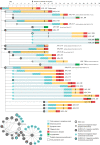Propagation of a hospital-associated cluster of COVID-19 in Malaysia
- PMID: 34886794
- PMCID: PMC8655495
- DOI: 10.1186/s12879-021-06894-y
Propagation of a hospital-associated cluster of COVID-19 in Malaysia
Abstract
Background: Hospitals are vulnerable to COVID-19 outbreaks. Intrahospital transmission of the disease is a threat to the healthcare systems as it increases morbidity and mortality among patients. It is imperative to deepen our understanding of transmission events in hospital-associated cases of COVID-19 for timely implementation of infection prevention and control measures in the hospital in avoiding future outbreaks. We examined the use of epidemiological case investigation combined with whole genome sequencing of cases to investigate and manage a hospital-associated cluster of COVID-19 cases.
Methods: An epidemiological investigation was conducted in a University Hospital in Malaysia from 23 March to 22 April 2020. Contact tracing, risk assessment, testing, symptom surveillance, and outbreak management were conducted following the diagnosis of a healthcare worker with SARS-CoV-2 by real-time PCR. These findings were complemented by whole genome sequencing analysis of a subset of positive cases.
Results: The index case was symptomatic but did not fulfill the initial epidemiological criteria for routine screening. Contact tracing suggested epidemiological linkages of 38 cases with COVID-19. Phylogenetic analysis excluded four of these cases. This cluster included 34 cases comprising ten healthcare worker-cases, nine patient-cases, and 15 community-cases. The epidemic curve demonstrated initial intrahospital transmission that propagated into the community. The estimated median incubation period was 4.7 days (95% CI: 3.5-6.4), and the serial interval was 5.3 days (95% CI: 4.3-6.5).
Conclusion: The study demonstrated the contribution of integrating epidemiological investigation and whole genome sequencing in understanding disease transmission in the hospital setting. Contact tracing, risk assessment, testing, and symptom surveillance remain imperative in resource-limited settings to identify and isolate cases, thereby controlling COVID-19 outbreaks. The use of whole genome sequencing complements field investigation findings in clarifying transmission networks. The safety of a hospital population during this COVID-19 pandemic may be secured with a multidisciplinary approach, good infection control measures, effective preparedness and response plan, and individual-level compliance among the hospital population.
Keywords: Epidemiological investigation; Hospital; Infection control; Multidisciplinary; SARS-CoV-2; Whole genome sequencing.
© 2021. The Author(s).
Conflict of interest statement
The authors declared no conflicts of interest with respect to the research, authorship, and/or publication of this article.
Figures



References
MeSH terms
Grants and funding
LinkOut - more resources
Full Text Sources
Medical
Miscellaneous

